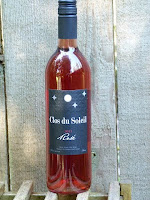Photo: Marimar Torres
A member of Spain ’s
best-known wine family, Marimar Torres moved to San
Francisco in 1975 to promote Torres wines in the United States
In 1986, backed by the family, she planted
Pinot Noir and Chardonnay vines in the Sonoma Valley Sonoma
Last week, she was in British Columbia British
Columbia : her winemaker is Napa
The Torres family’s history in wine began
in 1870 when Jaime Torres returned to Spain
The winery was rebuilt in 1940 by the
leader of the family’s next generation, Miguel Torres, to whom the honorific
“Don” was applied through much of his life, perhaps because he was hard-driving
and somewhat imperious. He was still influencing the business when he died in
1991 at age 81, having been succeeded by his son, Miguel A. Torres, Marimar’s
brother.
Miguel A., who was born in 1941, studied
enology in France Paris
According to a recent article in the Irish
Times, Miguel A. was “frustrated by the length of time it took his own father …
to hand over the reins.” So he laid down a policy that managing directors
should retire at 70. He has not retired
yet himself. But when he does, there are two family members being groomed. His
daughter, Meriea, is the winery’s technical director, and his son, Miguel
Torres Jr., is running the major winery that the family established in Chile
By basing herself in California
The first vineyard planted in Sonoma
The winery, which opened to the public in 1993 and has a capacity of
15,000 cases, is designed like a Catalan farm house.
And in the family tradition, Marimar, who was born in 1945, is being
joined in the California winery by daughter
Cristina, an economics major at Princeton
University
This is also a literate family. Marimar has written two cookbooks: The Catalan Country Kitchen and The Spanish Table: The Cuisines and Wines of
Spain
While the Torres wineries in Spain
and in Chile Pacific Ocean .
The cool growing conditions show through in the vivid and fresh
fruit flavours of the wines.
Here are notes on the wines that can be found in various private
wine stores in Vancouver California
Marimar Estate “Acero”
2009 Chardonnay (US$29). This is an exceptional
unoaked Chardonnay, vibrant with aromas of lime and tangerine and with flavours
of tropical fruits, including tangerines. Acero is Spanish for steel, the wine
having been fermented and aged in stainless steel. 90.
Marimar Estate “La Masía” 2009 Chardonnay (US$35).
La Masía is Catalan for farm house. This is a barrel-fermented Chardonnay, with
notes of honey and tropical fruit on the nose and with flavours grapefruit,
stone fruit, apples, hazelnut and spice – a very complex and satisfying wine.
92.
Marimar Estate “Dobles Lías” 2008 Chardonnay (US$45).
The name means double lees – the wine had extended lees contact in the barrel,
resulting in a toasty and rich texture. The flavours recall honey and marmalade
with subtle oak notes. 90.
Marimar Estate “La Masia”
2007 Pinot Noir (US$39). This is a bright, charming
Pinot Noir, loaded, as the winery’s own notes say, “with black cherry
flavours.” I also found raspberry and mocha. 90.
Marimar Estate “Mas
Cavalls” 2007 Pinot Noir (US$44). Mas Cavalls is
Catalan for horse farm because the winery also has an equestrian centre near
the vineyard. This is a stunning Pinot Noir, with rich layers of flavour –
black cherry, wild strawberry, spice, even earth notes. It is what the critics
would call “barnyard” and that is positive. 92.
Marimar Estate “Cristina”
2007 Pinot Noir (US$49). This wine is a special
selection of 20 barrels that the winery believes shows the best of the terroir
of the Don Miguel Vineyard. It is rich on the palate, with black cherry, plums
and blackberry flavours. The texture is classically seductive. 93.






























